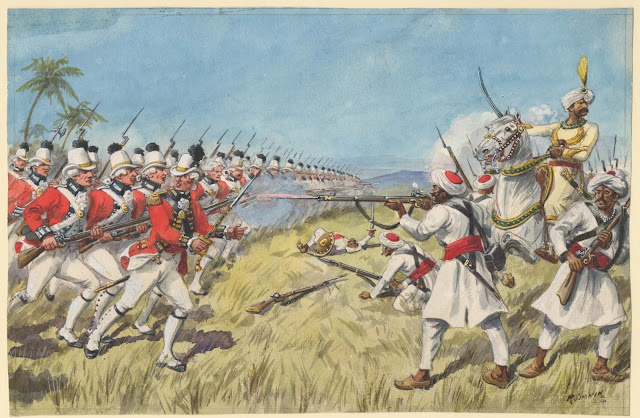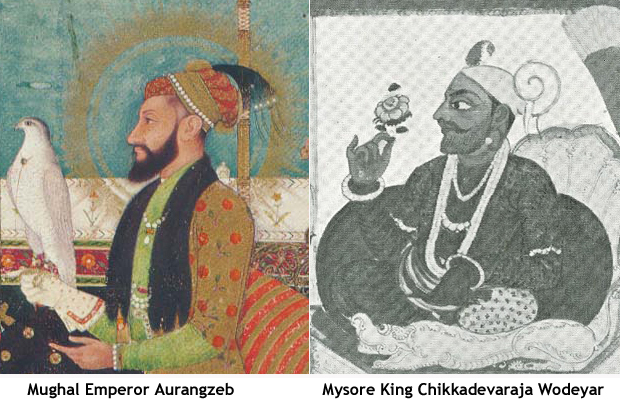How Haidar Ali and Tipu Sultan led India's first united front against the East India Company
Research and author: Ameen Ahmed
Background
The names of Mysore rulers Haidar Ali and his son Tipu Sultan often crop up when someone speaks of India's freedom movement. While there are some who say he was India's earliest freedom fighter, others argue he fought only to safeguard his own kingdom (1). There is an argument that the concept and dream of an independent India was never conceived until the 1857. That was the year when many Indians took up arms, particularly in the north, against East India Company. The British saw it as a mutiny of some disaffected soldiers. But many natives across the sub-continent call it the First War of Independence. They point to the fact that many Indians cut across the barriers of religion, and regions, and dreamed of a free India. But was that the first time someone dreamed of an India free of British? Let us look at some sources.
Haidar Ali's grand plan to oust British from India in 1780
The common thread of European colonialism connected many events that occurred in the decade of 1770, in different parts of the world. Thirteen states of America declared independence from British on 4th July 1776 (2). A couple of years later Louis XVI, the French King, recognized America's independence (3). Spain and Netherlands also stood up to British (4). Around the same time in India, Haidar Ali was planning a war against Britain, one whose battlefields would stretch across Europe and India. It sought an alliance of foreign powers, chiefly France, Persia, and Afghanistan (5).
The common thread of European colonialism connected many events that occurred in the decade of 1770, in different parts of the world. Thirteen states of America declared independence from British on 4th July 1776 (2). A couple of years later Louis XVI, the French King, recognized America's independence (3). Spain and Netherlands also stood up to British (4). Around the same time in India, Haidar Ali was planning a war against Britain, one whose battlefields would stretch across Europe and India. It sought an alliance of foreign powers, chiefly France, Persia, and Afghanistan (5).
There are various accounts of the history of Mysore Kingdom, particularly relating to Haidar Ali and Tipu Sultan, by European historians, or historians who have worked for the Europeans. But, among the handful of accounts by native sources written under native rule on either of these two men, is one by Nallapa. Known as Haidar Nama, it was published in 1784 CE. Nallapa was an officer working for Haidar Ali and his work gives a unique account of events in Haidar Ali's life, of which Tipu is an integral part. According to Nalappa, Haidar Ali once called a meeting of all his important men and proposed a grand plan to remove the British from India for ever. According to Nallapa, Haidar addressed the gathering that"...it was impossible to put down the British Power in India by defeating them in one place, for they had various places to draw upon- Madras, Bombay, Calcutta and above all England- and that it was not possible to put them down by any ordinary means". Nallapa continues, "His idea was that in order to create trouble for the English in India the only effective method was to bring about a war between the English and the French in Europe, then to set upon the people of Iran and Kandahar against Calcutta and Bengal, then to set up the Mahrattas against Bombay, and finally, taking the help of the French, the Nawab himself to attack Madras. By thus instituting wars in all the places at the same time so as to make it impossible for the people of one place to help those of another, the enemy would be destroyed and the country would become his." Haidar Ali apparently prepared to destroy the English after this writes the author.
Englishman Innes Munro wrote this, in 1789, about Haidar Ali's plan to destroy British in India:
'Meanwhile he used every endeavour, and sacrificed many private advantages, to keep his countrymen united in the same sentiments. No longer an implacable enemy to the Marrattas, he courteously solicited their friendship and alliance; and sent circular letters, couched in the strongest terms, to those whom he thought most hostile to our interests; exhorting them at once to form a league (in which he engaged to lead the van) and fall unanimously upon all the English settlements from the Ganges to Cape Comorin. He represented to them that, by this conduct, they should not only be the means of emancipating themselves and their unhappy countrymen from an humiliating state of tyranny and oppression, but have their names commemorated by all future ages as the glorious deliverers of their country' (6).
Accordingly, Haidar Ali attacked the British territories in Carnatic region in July 1780. Mysore Kingdom immediately scored many victories over the British. One of them was on September 10, 1780, when Tipu led a detachment of Mysorean Army to rout Col. Bailey's troops. Many British writers concede that it was among the worst defeats suffered on a battlefield by that nation. In 1914, a hundred and thirty-four years later, British writer FE Penny wrote this:
'...the defeat of the English under the unfortunate Colonel Baillie in 1780 by Haider Ali. Seven hundred Europeans and five thousand sepoys were killed or taken prisoner on that occasion, with guns and ammunition, tents, and stores. It was one of the worst disasters that ever happened to the British arms in India' (7).
Maistre de La Tour was a French officer of Haidar Ali. He wrote a biography of Haidar Ali that mentioned the events and the people associated with this warrior king. He describes an event in the second war where Haidar Ali asked for views of his council on whether to wait for French help before attacking the British. According to the author, Tipu suggested and inspired everyone around him that the attack against the British should go ahead without awaiting French troops. The Frenchmen eulogized Tipu for his role in the victory at Pollilur with the following words, 'It was this young prince who decided the battle that was attended with the deaths of the Colonels Baillie and Fletcher, by taking advantage of the disorder the English army was thrown into by the blowing up of their ammunition wagons, to fall on them with his cavalry. The total defeat of a detachment commanded by Colonel Brawlie is likewise an exploit of Tippou Saeb; who having began, like Alexander, to gain battles at the age of eighteen, continues to march in the steps of that Grecian hero, whom he may one day resemble as well by the heroism of his actions as by the multiplicity of his conquests' (8).
Eventually the Nizam, and the Marathas later on, backtracked. Haidar had to fight alone (9). Haidar Ali died on Dec. 7, 1782 but Tipu continued the war. That year, the Marathas and British ended their conflict by signing what is known as the Treaty of Salbai (10). In 1783, the French stopped supporting Tipu as they signed a peace treaty with the British. But Tipu continued to choke the Englishmen. In 1784, he lay siege to the port of Mangalore, in south western India. The starving British soldiers inside resorted to eating frogs and crows. The British desperately sought peace. Tipu agreed, not before thoroughly humiliating the British peace emissaries (ibid., 6). Thus ended the 2nd Anglo Mysore War, which originally began as India's first and the only alliance of native kingdoms aimed at eliminating the British from India.
References:
1) 'Tipu Sultan was a monarch, not freedom fighter: Karnataka HC', Website of India Today, Accessed on Sep. 09, 2020 from this link https://www.indiatoday.in/education-today/gk-current-affairs/story/tipu-sultan-349938-2016-11-03.2) Library of US Congress, accessed January 02, 2020, https://guides.loc.gov/declaration-of-independence.3) Website of Château de Versailles, accessed August 15, 2020. http://en.chateauversailles.fr/discover/history/key-dates/versailles-and-united-states-america-1778-1783.4) US Department of State Archive, Timeline of U.S. Diplomatic History: 1775-83, accessed July 25, 2020 https://2001-2009.state.gov/r/pa/ho/time/ar/14313.htm.5) Nallapa, 'Haidar Nama', 1784. Translated and reproduced by Krishna, M.H., Mysore Archaeological Report for 1930, 1934.6) Munro, Innes., 'A narrative of the military operations on the Coromandel Coast, against the combined force of the French, Dutch, and Hyder Ally Cawn, from the year 1780 to the peace in 1784; in a series of letters.', London, 1789.7) Penny, F.E., 'Southern India', 1914.8) Tour, Maistre de La., 'The History of Ayder Ali Khan, Nabob-Bahadur or New Memoirs concerning the East Indies with historical notes', 1784.9) Ahmed, Nazeer., 'Tipu Sultan - History of Islam, An Encyclopedia of History of Islam', accessed 9th September 2020 https://historyofislam.com/tippu-sultan/.10) Chalmers, George., 'A collection of treaties between Great Britain and other powers', 1790.
~ ~ ~
You may also like to read
Some British atrocities on civilians of south India during Anglo-Mysore Wars.
Some British atrocities on civilians of south India during Anglo-Mysore Wars.
How America celebrated a warrior from Mysore in 1781 CE.
When America named racehorses after Tipu Sultan and Haidar Ali over 240 years ago.
When America named racehorses after Tipu Sultan and Haidar Ali over 240 years ago.
How Mysore Kingdom overcame Britain’s industrial revolution inventions.
The Srirangapatna uprising of 1857 CE.
The Srirangapatna uprising of 1857 CE.
Hero, Tyrant or just another king? Shivaji's rule in Karnataka.
Persecution and massacres of Hindu Lingayats in context of religious conflict based politics.
Maratha attacks on temples and towns of Karnataka in 17th & 18th centuries CE.
The brave Kannadiga villagers of Tumakuru District who fought off Maratha army plunderers.
How Maratha Empire 'purified' its Brahmin advisor who raped Dalit woman (Shimoga,Karnataka,1791 CE).
Koodli Mutt massacre- The forgotten Peshwa Maratha attacks on Temples in Karnataka.
How Maratha Empire 'purified' its Brahmin advisor who raped Dalit woman (Shimoga,Karnataka,1791 CE).
Koodli Mutt massacre- The forgotten Peshwa Maratha attacks on Temples in Karnataka.
The forgotten reservations- How Brahmins survived 18th century wars in Mysore Kingdom.
Victims or Perpetrators? - Nayars of Kerala in 18th & 19th century CE
Victims or Perpetrators? - Nayars of Kerala in 18th & 19th century CE







Comments
Post a Comment
Thank you for visiting this blog and sharing your thoughts.